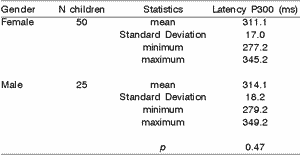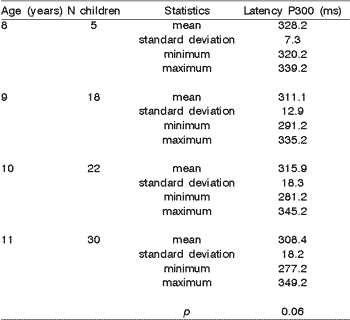IntroductionStudies have demonstrated that 15% to 20% of the population in school age has some kind of language and/or learning disorder and 70% of these children have some kind of hearing compromise1.
Children develop auditory perceptual skills together with neurological maturity, which takes place normally at the age of 9 years. However, some children do not acquire the skills needed for learning in the classroom, such as discrimination, memory, auditory attention, among others2.
The tests to assess peripheral hearing have already been studied and validated but the study of central abnormalities has gained constant and growing interest.
The assessment of central auditory pathways should be conducted using electrophysiologic procedures and special behavioral tests3.
Many electrophysiologic procedures have been used to assess the auditory central nervous system, such as auditory evoked potentials (AEP), by recording the action potentials of the central auditory pathways evoked by a sound source, and among them we can include the Auditory Brainstem Response (ABR), Middle Latency Response (MLR) and Long Latency Evoked Potential (among them the Cognitive Potential - P300).
Auditory evoked potentials (AEP) have taken a major role in audiology and in various areas of medicine owing to the fact that they are technically capable of capturing electrical potentials generated by various levels of the central nervous system (CNS) in response to an acoustic stimulation. In addition, these potentials are captured in a non-invasive fashion without discomfort to the patients, normally dispensing anesthesia or sedation, which improves their clinical applicability4, 5.
Late auditory potentials were primarily observed by Pauline Davis in 1939, who observed that occurrence of these potentials in the EEG. These responses presented latencies between 70 and 500ms, after stimulation6.
However, the identification and interpretation of AEP require skills and criteria by the examiner, such as knowledge of physiology, processes used for the recording, normal range data and effect of the variables such as age, gender, diseases and others5.
The neuroelectrical activity of P300 can be captured by electrodes placed on the scalp in various combinations. For example, the inverted electrodes can be placed in positions C3, C4, Cz, Pz and Fz, the non-inverted in each earlobe and the grounding electrode on the forehead. The P300 generating sites are not fully known yet, but it is believed that this potential has contributions from the hippocampus and/or posterior temporal lobe. The areas of the auditory cortex are also probably involved in the generation of this auditory potential7.
Long latency evoked potentials consist of perceptive and cognitive processes that result from high cerebral functions in response to an auditory event. P300, specifically, is related to cognition, because it is the situation in which the subject consciously recognizes significant changes in the acoustic stimulus8.
A characteristic of the long latency potentials is that they are less influenced by the physical properties of the stimulus and more affected by the functional use of the stimulus by the subjects’ body6, 8.
Musiek et al. (1994)9 observed that abnormal responses to adults in P300 have latencies greater than 350ms, but we should be attentive to the age factor. We should add 10ms for every decade of life to the value of latency in adults over the age of 45 years. For example, from 46 to 55 years, latencies greater than 360ms would be considered abnormal.
According to Jirsa (1992)10, the assessment of long latency components, P300, has been appointed as an effective tool for monitoring children with processing disorders, pre and post-therapeutic intervention.
The purpose of the study was to analyze P300 in children aged 8 to 11 years, with no abnormality in the behavioral test for auditory processing.
We are aware that the data present here do not response to all the questions posed on the use of P300 in children, but we hope that this study can be seen as an attempt to improve the assessment of these children.
Material and MethodWe studied 75 children aged 8 to 11 years, students of 3, 4 and 5th grades at public and private schools in the city of Bauru, state of São Paulo. We conducted complete audiological assessment and special tests for auditory processing using the following equipment: 1) Two-channel audiometer, model Unity – brand Siemens; 2) CD player; 3) Acoustic immittanciometry AZ26, by Interacoustic, and 4) to record P300, we used the equipment Biologyc, which comprises the tests of ABR, MLR and P300 coupled to the computer.
The audiological assessment comprised pure tone audiometry, speech discrimination, acoustic immittanciometry and special tests for central auditory processing (SSI with ipsilateral competitive message and Speech in Noise) and recording of P300.
The limits for normal range were 0 to 20dB HL (Davis & Silverman 1970)11 for pure tone audiometry and type A curve for tympanometry (Jerger, 1970). For auditory processing tests, SSI (Synthetic Sentence Identification) with MCI (Ipsilateral Competitive Message) and Speech in Noise, we were based on the normal range reported by Pereira & Schochat (1996)2.
The test was conducted while the child was siting with opened eyes. The active electrodes were placed on Cz and Fz (Figure 3) and connected to input 1, from channels 1 and 2, respectively, of the amplifier. The reference electrodes were placed on the right and left mastoid, interconnected to input 2, from channels 1 and 2 of the amplifier. The grounding electrode was placed at Fpz position.
The acoustic stimulus used was a tone burst, with alternate polarity, presented at an intensity of 75dB HL. The frequency used in the test for “frequent stimulus” was 1000Hz and for the “rare stimulus”, 2000Hz. We used 20% of rare stimuli randomly mixed with the frequent ones (80%).
We asked the examinee to identify the rare stimuli, counting it mentally. By the end of the test, we asked the patient to say how many stimuli he/she had counted to assess the effective participation. The mandatory condition to accept the tracing was the onset of a complex P300 wave.
We calculated the mean, standard deviation, minimum and maximum values for P300 latency, according to children’s age and gender. We used tests to compare the means between the male and female gender and Kruskal-Wallis test to compare the means of the different ages of children.
ResultsWe assessed 77 children aged 8 to 12 years being that 52 (67.5%) were female and 25 (32.5%) were male subjects. All children enrolled in the study presented audiometry and tympanometry within normal ranges and there were no abnormalities in auditory processing tests - SSI with MCI and Speech in Noise, at the time of the evaluation.
Table 1 refers to the distribution of mean, standard deviations, maximum and minimum values of P300 latency, according to gender. We did not observe statistically significant difference between male and female genders (p=0.47).
Table 2 shows distribution of mean, standard deviations, maximum and minimum values of P300, according to age. There was no statistically significant difference among the studied ages (p=0.06).
Table 1. Distribution of mean, standard deviation, and minimum and maximum values of P300 latency, according to gender.

Table 2. Distribution of mean, standard deviation, and minimum and maximum values of P300 latency, according to age.

In this study, we observed some characteristics of tracing and collected data that can help in the evaluation of cognitive potential or event-related potential (P300).
In the present study, we obtained values of P300 latency for female subjects with mean latency of 311ms, minimum and maximum values of 277.2 and 345.2ms. For males, we observed mean latency of 314ms, with minimum and maximum values of 279.2 and 349.2ms. There was no statistically significant difference in P300 latency between male and female gender (p=0.47). The same results were also found in another study9.
We observed that latency tended to reduce as a result of age, showing as an average response: 8 years, latency of 328.2ms (minimum value of 320.2 and maximum of 339.2ms); 9 years, 311.1ms (291.2 to 335.2ms); 10 years, 315.2ms (281.2 to 345.2ms); 11 years, 308.4ms (277.2 to 349.2ms), thus, with no statistically significant difference among studied ages (p=0.06), despite the fact that we had observed a reduction in latency as age increased To conclude, the analysis of the results provided the conclusion that age is an important factor when recording this potential, since maturation of the central auditory hearing system, which is present at about 10 years of age, tend to reduce latency of P300 as age increases; gender does not interfere in P300 latency. The results of the present investigation were in agreement with the data from other studies similarly conducted8, 12.
References 1. Rupp R. The audiologist’s role in the evaluation of auditory perceptual and processing abilities in young school-age children. In: Bradford L. Audiology: An Audio Journal for Continuing Education. New York: Grune & Stratton, Inc.; 1978.
2. Page JM. Central auditory disorders in children. The Otolaryngol. Clin North Am 1985;18(2):323-35.
3. Chermak GD, Musiek FE. Conceptual and historical foundations. In: Central Auditory Processing Disorders – New Perspectives. San Diego: Singular Publishing Group; 1997. cap. 2, p. 27-70.
4. Ferraro JA & Durrant JD. Potenciais auditivos evocados: visão geral e princípios básicos. In: Katz J. Tratado de Audiologia Clínica. Ed. Manole; 1999. cap. 22, p. 315-36.
5. Jacobson JT, Hyde ML. Uma introdução aos potenciais evocados. In: Katz J. Tratado de audiologia clínica. 3ª ed.; 1989. cap. 25, p. 504-41.
6. Kraus N, Mcgee T. Potenciais auditivos evocados de longa latência. In: Katz J. Tratado de Audiologia Clínica. Ed. Manole; 1999. cap. 27, p. 403-20.
7. Musiek FE, Baran JA, Pinheiro ML. Introduction to Case Studies in Neuroaudiology. In: Neuroaudiology – Case Studies. Ed. Singular Publishing Group; 1994.
8. Mcpherson DL. Long latency auditory evoked potentials. In: Late Potentials of the auditory system. Singular Publishing Group, Inc; 1996. p.7-21.
9. Munhoz MSL, Silva MLG, Ganança MM, Caovilla HH, Frazza MM. Respostas auditivas de longa latência. In: Munhoz MSL, Caovilla HH, Silva MLG, Ganança MM. Audiologia clínica. Ed. Atheneu; 2000. cap.14, p. 231-42.
10. Jirsa RE. The clinical utility of the P3, AERP in children with auditory processing disorder. Journal of Speech and Hearing Research 1992;35:903-12.
11. Davis H & Silverman RS. Hearing and deafness. New York: Rinehart & Winston apud Frota, S. Avaliação básica da audição. In: Fundamentos em Fonoaudiologia; 1998. cap.3, p. 41-59.
12. Barajas JJ. The effects of age on human P3 latency. Acta Otolaryngol (Stockh) Suppl. 1991;476:157-60.
13. Pereira LD, Schochat E. Processamento Auditivo Central. Ed. Lovise; 1996.
1 Doctorate studies in Public Health under course, supported by FAPESP scholarship, Area of Major: Epidemiology, University of São Paulo - USP.
2 Otorhinolaryngologist, Center for Audiological Research, Hospital de Pesquisa e Reabilitação de Lesões Lábio-Palatais, University of São Paulo (HPRLLP-USP), in Bauru-SP, and Faculty Professor, Post-Graduation Program, PUC-SP.
3 Ph.D., Professor, Department of Epidemiology, School of Public Health, University of São Paulo.
Address correspondence to: Silvana Maria Bruno da Costa – Rua Conselheiro Lafaiete 40 apto 32
Santos SP 11040-280
Tel/Fax: (55 13) 3236-0799 or Faculdade de Saúde Pública USP/SP: Tel (55 11) 3066-7777
Article submitted on March 26, 2002. Article accepted on June 06, 2002


